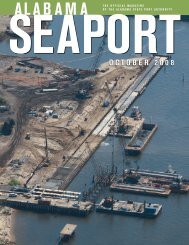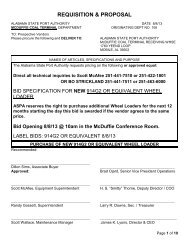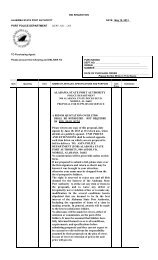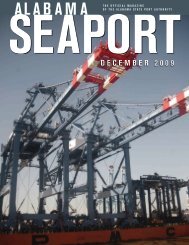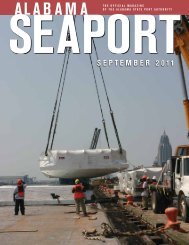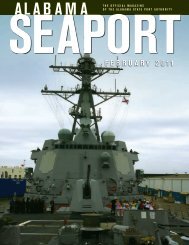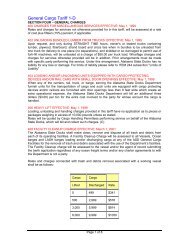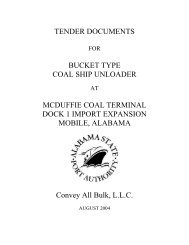August 2012 - Alabama State Port Authority
August 2012 - Alabama State Port Authority
August 2012 - Alabama State Port Authority
Create successful ePaper yourself
Turn your PDF publications into a flip-book with our unique Google optimized e-Paper software.
Regardless of who was at fault, one fact was inarguable:<br />
The NETTIE CUSHING struck the METIS about 40<br />
feet abaft the bow, even with the pilothouse. Jameson<br />
recounted that he hailed the METIS to ask for assistance,<br />
but his cries went unanswered. Burton claimed that after<br />
striking his ship, the NETTIE CUSHING continued on<br />
her way.<br />
On board the schooner, although she had sustained<br />
heavy damage to her bow, Jameson determined that the<br />
NETTIE CUSHING remained seaworthy, and he set a<br />
course for New London, Conn., where he could put in<br />
for repairs.<br />
The collision had not seemed that bad to those in<br />
the METIS. There was no great shock or loud noise<br />
associated with the crash. Most of the passengers were<br />
sleeping in their cabins and were unaware that there had<br />
been an incident. A number of passengers did know that<br />
something had happened, however, and went up on deck,<br />
where they were informed that the ship had sustained<br />
only slight damage and that they should go back to bed.<br />
Upon going below to check for damage, however, the<br />
engineer and his men quickly discovered a deep gash<br />
below the waterline, with water pouring into the ship. The<br />
damage was catastrophic.<br />
Capt. Burton immediately ordered his helmsman to make<br />
for the shore in an effort to beach the ship before she<br />
sank. The ship heeled to port and began a desperate run<br />
for safety. She had only covered a mile when the flooding<br />
waters reached the engine room and extinguished the<br />
boiler fires. The pistons and gears ground to a halt, the<br />
propeller slowed to a stop, and the lights flickered and<br />
died, as the ship lost all power. She was now at the mercy<br />
of the elements. Taking water, listing badly and buffeted<br />
by wind and waves, the METIS was in imminent danger<br />
of sinking. Capt. Burton gave the order to abandon ship.<br />
The passengers had been told to dress and leave their<br />
cabins, and they were now told to don life vests. This<br />
remains a point of contention, as some passengers would<br />
later claim that the crew failed to keep the passengers<br />
informed and, in some instances, offered no assistance<br />
to passengers. The METIS carried only one lifeboat and<br />
one life raft, which were quickly filled. Burton refused to<br />
leave his command, electing to remain with the majority<br />
of the passengers and doing what he could to keep them<br />
calm. As the METIS began to settle in the water, those<br />
on board climbed higher, until all were on the hurricane<br />
deck. The ship slipped beneath the churning waves, and,<br />
miraculously, the hurricane deck, which had been added<br />
only a year earlier, broke free and floated. Nevertheless,<br />
The Watch Hill Lighthouse was authorized by Congress in 1808<br />
following a series of wrecks off the coast.<br />
some opted to jump into the water in an attempt to swim<br />
to shore. Others grabbed for bits of flotsam in hopes of<br />
remaining afloat long enough for help to arrive.<br />
As the day dawned, the people of Watch Hill learned of<br />
the tragedy. Crowds gathered on the beach to watch and<br />
to help survivors ashore, if possible.<br />
Capt. Jared Crandall, the keeper of the lighthouse; and<br />
Capt. Daniel Larkin, a retired lighthouse keeper who now<br />
served as captain of the Life-Saving Station at Watch<br />
Hill, launched a boat from the station. Joining them were<br />
Life-Saving Servicemen Albert Crandall, Frank Larkin and<br />
Byron Green. Capt. John Harvey and crewmen Courtland<br />
Gavitt, Edwin Nash, Eugene Nash and William Nash put to<br />
sea in a fishing smack. Word of the accident was sent to<br />
the Revenue Cutter Service Station at Stonington, Conn.<br />
At 7 a.m., what remained of the hurricane deck could<br />
be seen drifting about a mile offshore, crowded with<br />
survivors. The lifeboat and life raft were just off the beach,<br />
and about two dozen citizens along the shore formed two<br />
The “dreadful scene” at Watch Hill as local residents flocked to the beach in an effort to assist survivors. Watch Hill Lighthouse can be seen in<br />
the distance in this contemporary illustration from Harper’s Weekly.<br />
human chains to help bring survivors to safety. Despite<br />
their heroic efforts, several of the victims fell into the<br />
surf and drowned, and others were carried away by the<br />
undertow. The hurricane deck reached shore at about<br />
8:15; most of the men on board were rescued, but some<br />
of the women were too exhausted to hold on and drowned<br />
at the last moment. It was, according to The New York<br />
Times, “a dreadful scene.”<br />
The boat from the Life-Saving Station and the fishing<br />
smack were able to rescue more than 30 passengers.<br />
The U.S. Revenue Cutter MOCCASIN arrived on scene<br />
at about 10 a.m. and took on board the survivors from the<br />
two boats, picking up several more survivors from the sea,<br />
including a passenger found clinging to a cork mattress,<br />
a young boy from Providence, R.I., and a number of the<br />
ship’s crew, including her first officer, chief engineer, two<br />
quartermasters, the freight clerk and the ship’s purser. The<br />
MOCCASIN also took on board the bodies of 18 victims.<br />
As word of the wreck spread, more vessels arrived on<br />
scene to assist, but most inherited the grim task of pulling<br />
bodies from the water. The yacht JOSIE and the schooner<br />
A.B. BELDEN fished a number of bodies from the sea,<br />
but the dead continued to wash ashore up and down the<br />
coast of New England for the next few days.<br />
The survivors, including Capt. Burton and steamship<br />
agent Albert Gallup, were taken to the Ocean House<br />
Hotel, where they were provided medical care, food and<br />
drink. Hotel guests also donated clothing to the survivors,<br />
A Life-Saving Service crew from Watch Hill rescued survivors.<br />
many of whom had left their cabins in various states of<br />
undress. The wreck generated a number of tragic stories.<br />
Perhaps the most tragic was that of George Howard.<br />
Married in Sharon Springs, N.Y., on Aug. 29, Howard and<br />
his new bride had embarked in the METIS in New York<br />
City to begin their honeymoon trip. They were traveling<br />
to Pawtucket, R.I., via Providence, when the accident<br />
occurred. The couple had put on their life preservers and<br />
gone on deck as instructed. The two were struck by a<br />
large wave and swept into the ocean. They soon became<br />
separated in the high seas.<br />
One of the bodies recovered by the A.B. BELDEN was<br />
that of a woman wearing a life preserver. She carried<br />
28 <strong>Alabama</strong> Seaport • <strong>August</strong> <strong>2012</strong><br />
<strong>Alabama</strong> Seaport • <strong>August</strong> <strong>2012</strong> 29




